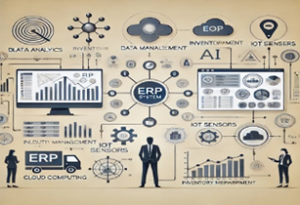- 17.12.2024
- Posted by: Artem Cherkizov
- Category: Articles, News, Press Releases
A complete guide to ERP system implementation with examples and benefits
Modern business is becoming increasingly dependent on technology, and ERP systems (Enterprise Resource Planning) play a key role in this transformation. These systems allow enterprises to integrate all major processes — from financial management to supply chains — into a single platform. This article explores the key aspects of ERP implementation, its benefits, implementation stages, and how to avoid mistakes.
What is a Modern ERP System?
 |
ERP (Enterprise Resource Planning) is a business process management tool that integrates key enterprise functions such as finance, logistics, production, and HR management. ERP systems create a unified information environment where all subsystems work synchronously, eliminating data duplication and ensuring operational interactions. Modern ERP solutions actively leverage innovative technologies such as cloud platforms, artificial intelligence (AI), and the Internet of Things (IoT), enhancing their functionality and making management more efficient. |
Benefits of Modern ERP Systems for Various Industries
 |
|
Political Factors in Choosing ERP
Selecting an ERP system requires considering the current geopolitical situation. Using solutions from sanctioned countries poses risks such as lack of updates, loss of technical support, and data security threats. Preference should be given to trusted vendors that offer reliable local support.
Current Trends in ERP
1. Cloud Infrastructure
Cloud-based ERP systems are becoming the standard, offering:
- Cost Savings: Avoidance of expensive local IT infrastructure.
- Scalability: Flexibility to expand system capabilities.
- Global Access: Secure access from anywhere in the world.
- Reliable Data Storage: With backup and recovery features.
2. Artificial Intelligence (AI)
AI in ERP enables:
- Optimizing production and inventory management.
- Forecasting demand based on big data analysis.
- Automating daily tasks, including calculations and reporting.
- Real-time data processing for operational decisions.
3. Internet of Things (IoT) as part of ERP
Modern ERP systems already include IoT technologies, making them powerful tools for automation and management. With IoT, ERP systems easily connect to production equipment, sensors, and other smart devices, providing:
- Equipment Monitoring: Real-time data about device status, helping prevent breakdowns.
- Smart Warehouses: ERP manages storage parameters such as temperature and humidity using connected sensors.
- Production Processes: ERP automatically receives data on production output, allowing for timely adjustments and improved efficiency.
ERP The Impact of IoT and AI on ERP Efficiency
Integrating IoT and AI into ERP systems unlocks new business opportunities:
- IoT: Devices connected to ERP provide real-time data, such as equipment status.
- AI: Improves demand forecasting and analyzes large datasets, enhancing planning accuracy.
Stages of ERP Implementation
- Needs Analysis: Identifying problems and goals for implementation.
- System Selection: Researching the market and comparing solutions.
- Data Preparation: Cleaning and migrating data.
- System Configuration: Customizing modules to fit business specifics.
- Staff Training: Ensuring employees have the skills to work with the system.
- Launch: Gradual implementation and testing.
How to Avoid Mistakes During ERP Implementation
- Incorrect System Selection: Carefully study the functionality.
- Insufficient Training: Invest time in staff training.
- Weak Support: Ensure technical support availability from the vendor.
Successful ERP Implementation Cases
● Manufacturing: Implementing IoT sensors and ERP reduces equipment downtime by up to 25%.
● Logistics: Collaboration with manufacturers for procurement using cloud-based ERP systems cuts order processing time by 30%.
● Retail: Demand forecasting with generative AI reduces costs by up to 20%.
Business owners, contact us, and we will present real cases of improvements achieved with ERP systems at enterprises in your industry.
Conclusion: Investing in ERP as a Step Towards the Future
Modern ERP systems integrate the latest technologies such as IoT, AI, and cloud solutions, helping businesses become more flexible and efficient. This is an investment that not only optimizes current processes but also ensures competitiveness in the future.
Implementing ERP is a strategic decision that requires time, resources, and effort. However, a proper approach to system selection and implementation guarantees success. Contact RBC Group Solutions to discuss how ERP can improve your business.
Frequently Asked Questions
- How long does ERP implementation take?
On average, from 6 to 12 months, depending on complexity. - What is the cost of an ERP system?
Costs vary depending on functionality, the number of users, and business specifics. - How to choose the right system?
Evaluate your business processes and compare popular solutions, considering scalability and technical support.

